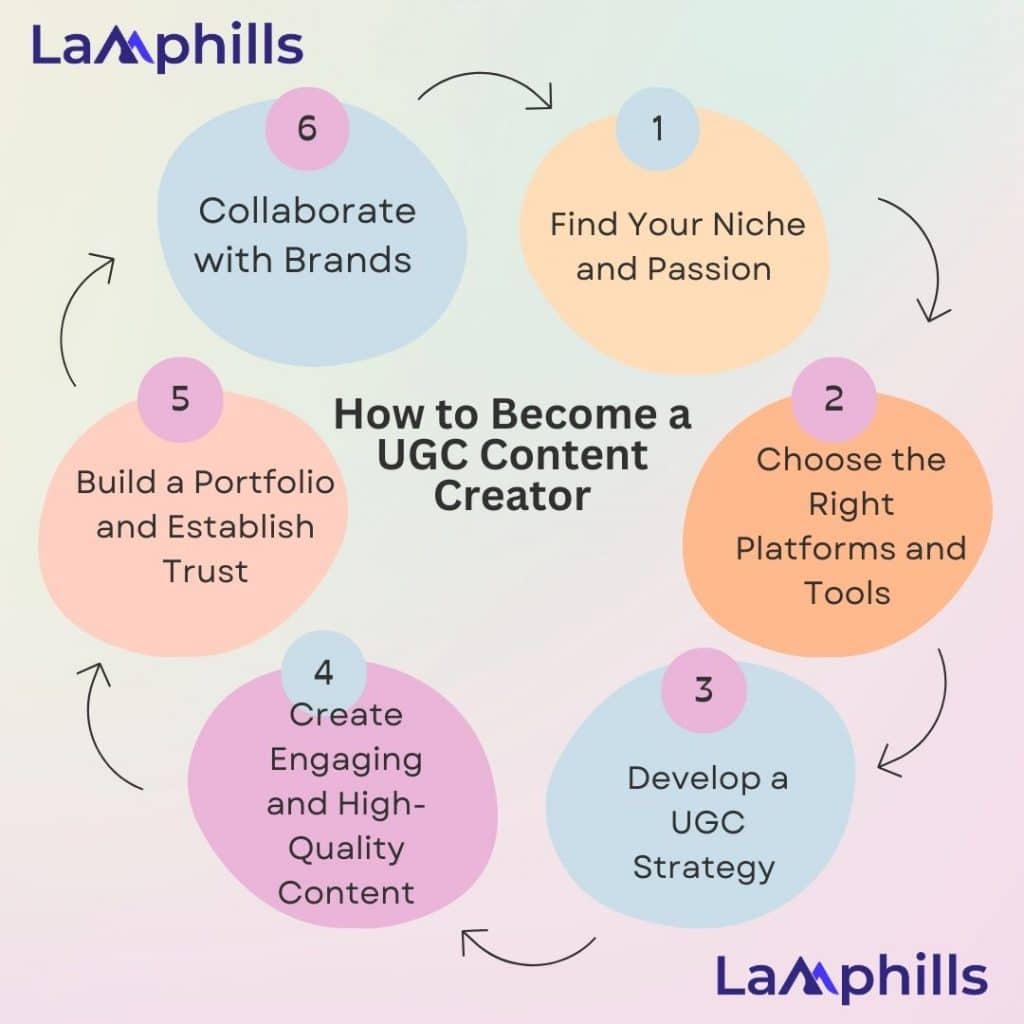Have you ever scrolled through your social media feed and wondered how some people turn their everyday experiences into content that brands pay for? That’s the magic of being a UGC content creator. I had no idea that my casual posts could lead to such opportunities. Becoming a UGC content creator isn’t just about having a knack for creating engaging content; it’s about understanding what resonates with your audience and brands. The first time a brand reached out to me after I posted a simple review of a product I loved. That moment was a game-changer.
So, how do you build a UGC content creator portfolio that stands out? What steps can you take to become a successful UGC content creator, and which platforms are the best to showcase your work? Explore this guide and see how you can turn your passion for content into a rewarding career.
Key Point
- A UGC Content Creator creates content like videos, photos, or posts that can be shared on social media or websites.
- To become a UGC Content Creator, First find a niche and passion, identifying an area that matches personal interests and expertise. Then, choose the right platforms and tools, such as Instagram, YouTube, or TikTok, that fit the chosen niche. Then, develop a UGC strategy by outlining the type of content to create, posting frequency, and the desired style or tone.
- A portfolio is a visual resume that showcases a creator’s best work, highlighting their creativity, technical skills, and ability to create different types of content. It tells a story about the creator’s unique style and connection with audiences, aiming to attract brands for collaborations.
- The types of content to include in a portfolio should display versatility and expertise, such as videos (short-form like TikToks and longer content like vlogs), photographs (lifestyle shots, product photography), and optionally, written content (blog posts, social media captions).
- Several platforms help UGC creators connect with brands for collaborations. For instance, Clip pays per video and offers free products. HashtagPaid is high-paying with no minimums but has fewer opportunities. Trend.io allows creators to set their rates for collaborations, while Aspire.io requires a minimum number of followers but provides many brand deals.
Ugc Content Creator

Credit: Freepik
A UGC Creator makes content like videos, pictures, or posts that people can see and interact with on social media platforms or websites. They’re regular folks who enjoy sharing their thoughts, ideas, or creativity online for fun. This can include anything from cooking tutorials and travel vlogs to fashion tips and gaming streams. Their content is meant to engage with others, spark conversations, and build a community around shared interests. UGC Creators often start as hobbyists, sharing what they love, and sometimes they even turn their passion into a career as their audience grows.
UGC Content Creator Portfolio
It’s a collection of your best work, acting as a visual resume highlighting your creativity, technical skills, and ability with different types of content. Think of it as your chance to tell brands a story about your unique style, your connection with audiences, and how you can boost their marketing.
Types of UGC to Showcase in Your Portfolio
The magic of a UGC creator portfolio is in its ability to display your versatility and expertise in crafting engaging content. But with so many types of UGC, where do you start? Don’t worry, aspiring creators! This section dives into the different kinds of UGC you can include in your portfolio, turning it into a powerful tool that attracts brands and secures collaborations.
Unleashing Your Creativity: A Look at Different UGC Formats
- Video Content: The visual powerhouse of UGC! Include short-form videos like TikToks and Instagram Reels and longer content like vlogs and tutorials. Show off your product reviews, unboxing experiences, and creative storytelling through captivating video formats.
- Photographic Prowess: UGC is a visual playground. Highlight your photography skills with lifestyle shots featuring products, close-up product photography, and stunning flat lays that capture a brand’s essence.
- Written Magic (Optional): While visual content is critical, some brands might want written elements like blog posts or social media captions. If writing is your strength, include examples showing your storytelling abilities and understanding of brand voice.
Remember: Don’t Just Throw Everything in Your UGC Portfolio!
- Tailor Your Content: Focus on UGC formats that resonate with your niche and the brands you want to work with. For example, a travel blogger wouldn’t showcase gaming content.
- Quality over Quantity: Curate your absolute best work. Each piece should highlight your technical skills, creativity, and ability to connect with your target audience.
- Beyond the Formats: Building a Cohesive Portfolio
- Storytelling is Key: Craft a narrative through your portfolio highlighting your unique style and approach to content creation.
- Call to Action: Make it easy for brands to contact you by including a clear call to action, such as an email address or a link to your personal website.
You’ll create a UGC portfolio that stands out by strategically incorporating these diverse UGC formats and storytelling elements. In the next section, we’ll look at some inspiring UGC portfolio examples for beginners, offering valuable insights to kickstart your UGC creator journey!
Inspiring UGC portfolio examples: Avery Davis
How to Become a Ugc Content Creator
Here are a few steps to becoming a Ugc content creator:

#1. Find Your Niche and Passion
Start by identifying a niche that matches your passions and expertise. Whether it’s cooking, fashion, travel, or gaming, choosing something you love will help you create authentic and engaging content. Explore different areas within your chosen field to find your specific niche and stand out.
#2. Choose the Right Platforms and Tools
Pick platforms that fit your niche. Instagram, YouTube, TikTok, and blogs each have unique audiences and content formats. Use content creator tools like AI content writers, rank-tracking software, and analytics tools to enhance your strategy.
#3. Develop a UGC Strategy
Outline the type of content you’ll create, how often you’ll post, and the style or tone you want to use. Understand your audience and their preferences to create content that resonates with them.
#4. Create Engaging and High-Quality Content
Make sure your content is compelling, informative, and visually appealing. High-quality videos, images, and well-crafted text are vital to capturing and keeping your audience’s attention. Consistency and uniqueness are crucial to standing out.
#5. Build a Portfolio and Establish Trust
As you create content, build a portfolio to showcase your work. This helps establish trust with your audience and potential collaborators. Consistent quality and authenticity will help you gain credibility in your niche.
#6. Collaborate with Brands
Working with brands can be a big step in your UGC creator journey. Meet the eligibility criteria for your platform first. For example, in the past year, YouTube has required at least 1000 subscribers and 4000 watch hours for monetization. Understanding and meeting these requirements are essential steps toward brand collaborations.
Ready to start your UGC creator journey? Follow these steps and watch your audience grow!
Creating compelling and impactful content is a cornerstone of any successful digital strategy. Whether you’re crafting blog posts, shooting videos, or designing graphics, the process involves more than just creativity; it requires meticulous planning, optimization, and continuous improvement. To ensure your content not only captures attention but also resonates with your audience and achieves your goals, it’s crucial to follow a structured approach.
Download this Comprehensive Content Creation Checklist, which is designed to guide you through every step of the content creation process.
UGC Content Creator Platform

Credit: Freepik
Here are the Best Platforms for UGC Creators
When we talk about platforms, we’re referring to any place that connects you with brands. This could mean paid collaborations, gifted jobs, or just a way to network. Essentially, it is anywhere that helps you find paid work. Here’s a rundown of some great places to start your UGC creator journey.
#1. Clip
Clip operates in the UK, Australia, and the US, focusing only on UGC creators. You don’t need followers or even your social media accounts to join. They do require an intro video and at least 3 portfolio videos. On Clip, you get paid per video; the longer the video, the more you earn. Creators also get free products and can earn extra through captions, music, video variations, and tips.
Pros: Lots of work and compensation options
Cons: High competition; you need to build a good reputation
Brands: Naughty, Cult Furniture, Yamaha
#2. hashtagPaid
#paid moves away from traditional influencer marketing, targeting different sections of the sales funnel. Brands create campaign briefs, and you apply by indicating your interest and explaining why you’re a good fit. Brands can also use Whitelisted Ads to push your content as paid ads.
Pros: High paying, no minimums
Cons: Few opportunities (1-2 per week)
Brands: Sephora, IKEA, Phillips
#3. Brand Meets Creators
Brand Meets Creators isn’t a typical platform. It’s a weekly email newsletter with brand deals you can apply for via a Google form. It can be very competitive, but you get around 15-20 potential deals each Thursday.
Pros: No barrier to entry; jobs come to you
Cons: No big brands; high competition
Brands: Happy Llama Tech, Grand Welcome
#4. Trend.io
Trend.io connects UGC creators with brands looking to collaborate. You set your rates and choose which offers to accept. Trend.io provides tools to help improve your content and grow your following.
Pros: High paying, no minimums
Cons: Few opportunities (1-2 per week)
Brands: Sephora, IKEA, Phillips
#5. Aspire.io
Aspire.IO started as an influencer platform but now includes UGC. You need 2,500 Instagram followers or 1,000 TikTok views to join. Aspire.io has many brand deals available, especially if you have a larger following.
Pros: Easy to start conversations with brands; good for gifted collaborations
Cons: Minimum criteria to join
Brands: Loreal, Hoover, Vichy Laboratories, Lancome, Coco & Eve
#6. Billo
Billo focuses on UGC creators with a wide variety of brands and agencies. Signing up is easy through their app. Beginners and professional UGC creators can find work here, and you get paid more if you become a PRO.
Pros: Lots of opportunities; good income potential
Cons: Mainly focuses on the US market
Brands: Hello Fresh, Harry’s, COOLA, AdKings
#7. Insense
Insense partners with big social media platforms. You can apply for various job categories, including UGC only, UGC + paid posting, and influencer whitelisting. Some jobs require you to buy the product first, but it’s generally safe.
Pros: Typically, higher pay
Cons: Brands get rights to your content indefinitely
Brands: Opopop, Blissy, Dots for Spots
#8. Collabstr
Collabstr is a self-serve platform where brands find creators for upcoming campaigns. It’s another way to be visible to brands and let them come to you. Collabstr takes a 15% cut, but it’s worth it to gain visibility.
Pros: Another platform for visibility
Cons: Lots of back and forth with brands
Brands: Hopper, Click Up
#9. Popular Pays
Popular Pays allows brands to work with smaller or enterprise brands and get paid. UGC opportunities are rare but available. They often have quick turnaround times and detailed requirements.
Pros: Paid gigs available
Cons: Can be demanding with quick deadlines
Brands: Neutrogena, Getir, AngelSense, Lifesum
#10. Upwork and Fiverr
Both platforms let you offer UGC services to clients. They take a cut but handle invoicing and protection. It’s challenging to gain clients, but perseverance pays off.
Pros: Daily opportunities
Cons: Low pay, dodgy clients, takes time to optimize your profile
Brands: Various independent retailers and DTC brands
Now, over to you. Choosing the right platform can be overwhelming, but don’t worry. Try them all and see what works best for you.
Read: Fiverr Competitors in 2024: Top 11 Platforms
UGC Content Creator Jobs
- Social Media Content Creator
- Social Media Manager
- Digital Marketer
- Senior Copywriter – Brand
- Senior Copywriter – Brand
What Are the Pros and Cons of Ugc?

Credit: Freepik
The Pros of User-Generated Content (UGC)
User Generated Content (UGC) comes with many benefits. Here are some of the top advantages:
#1. Boosts Authenticity
UGC makes your business look more genuine because it shows authentic and unfiltered customer perspectives. This acts as social proof. Users sharing their experiences, reviews, and testimonials creates a trustworthy image for your brand. People tend to believe their peers more than traditional advertising. UGC also humanizes your brand, showing its impact on real lives and reflecting a diverse customer base.
Read: How to Boost Your Brand Using E-commerce Marketing Automation: Best Tools and Platforms
#2. Improves Website Engagement
UGC can make your website more engaging for visitors. Featuring customer reviews, testimonials, images, comments, and discussions turns your site into a dynamic platform. This personal touch helps visitors connect with real experiences and opinions from their peers, keeping them on your site longer and encouraging them to explore more pages. Plus, UGC provides a constant stream of fresh content, attracting more organic traffic.
Read: Content Websites Mistakes You Must Avoid (Learning These the Hard Way Cost Me $32k)
#3. Enhances SEO
UGC is great for SEO because it constantly adds relevant content to your site. Search engines prefer dynamic and updated content. Customer reviews, testimonials, and comments contribute to this ongoing stream. UGC’s diverse keywords and phrases naturally improve your site’s search engine rankings, making it more discoverable. User engagement with UGC also signals to search engines that your site is valuable and credible, boosting its ranking.
#4. Increases Conversion Rates
UGC can help boost your conversion rates. When potential customers see real experiences others share, it builds trust and confidence in your product or service. This helps prospective buyers make informed decisions and reduces their doubts. The relatable nature of UGC creates an emotional connection between your brand and its audience. This authenticity not only eases concerns but also shapes a positive perception, making visitors more likely to become customers.
Read: How I Mastered Brand Communications: Strategies for Clear and Effective Messaging
There are many pros to UGC. Want to benefit from the power of User Generated Content? Book a demo of the Flowbox platform.
The Cons of User-Generated Content (UGC)

Credit: Freepik
While UGC is a successful part of many marketing strategies, it does come with some challenges. Here are the main cons:
#1. Risk of Negative Content
One major drawback of UGC is the risk of harmful content. While UGC shows real customer experiences, it can also include negative reviews, comments, or feedback. Harmful content can harm your business’s reputation and deter potential customers. Even with moderation, some harmful content might slip through, making it hard for brands to control their online image. It’s essential to have plans to handle and respond to negative UGC quickly.
#2. Requires Monitoring
Another downside of UGC is the need for continuous monitoring. UGC offers valuable insights and engagement, but it can also be misused, spammed, or contain inappropriate content. Regular monitoring is necessary to maintain the quality and relevance of UGC, ensuring it aligns with your brand’s values and guidelines. Failing to monitor UGC adequately can result in the spread of misleading information, harming your brand’s reputation and potentially leading to legal issues.
#3. Additional Costs
While UGC is often seen as a cost-saving marketing strategy, it requires management, moderation, and compliance resources. This can add up. Encouraging users to create content may also require spending on campaigns or rewards. Investments in promotions, contests, or prizes might be needed to engage users. Managing and interacting with user content takes time and manpower. When planning for UGC, it’s important to account for these costs to ensure it works well and is sustainable.
#4. Unreliable Sources
One issue with UGC is the uncertainty about its sources, which can lead to unreliable information. Since different people create UGC, the accuracy and truthfulness of the content can vary. Sometimes, verifying if the information users share is accurate is hard because it could be biased or intentionally false.
Relying on UGC without careful verification can spread wrong information, damaging how people see your brand and reducing customer trust. To address this, have substantial plans to check content, ensure it’s true, and set clear user rules. You might also need to request UGC permission before displaying it.
Related Post
How To Find YouTube Influencers for Your Brand: 7+ Proven Ways
The Power of Shared Media: Leveraging Collective Content for Maximum Impact
Best User-Generated Content Platforms for Your Brand in 2024: How to Choose the Best One






